Mealworm Care Sheet
Common name: Mealworm Scientific name: The mealworm is the larval form of the Mealworm/flour/darkling beetle: Tenebrio molitor Lifespan: Mealworms can live out the entire cycle from egg to larva to pupa to adulthood in a matter of a few months. The benefits of Mealworms as a food item.Mealworms are high in protein and fat so are good for a host of reptiles and amphibians that need building up. This is also a reason why mealworms should not be regarded as a stable, as reptiles and amphibians can become overweight if this is the only food item available, so should always be offered as part of a varied and well-balanced diet. A wide range of lizards and amphibians will take mealworms readily, even when they are reluctant to take other prey items, although some delicate species should not be fed mealworms due to their hard exoskeleton which can be difficult to digest. Both the larva and the beetles are edible. They are also very easy to keep, cheap to house and feed, fast to breed and odourless, so make a great live food to have readily available within the home. Mealworm Housing Mealworms are nocturnal by nature, so keeping them in a dark place is recommended. They can also be covered with paper or egg box bottoms so they can hide and feel secure. Mealworm TemperatureMealworms are alright to be kept at room temperature and at relative normal humidity, although they may breed faster in warmer conditions. Mealworm Feeding Fresh vegetables and fruit need to be added as Mealworms will source all their water needs from these items. Potato, carrot and apple are good to use for this purpose, but almost any vegetable will suffice.
Notes on Breeding Mealworms Gestation of the eggs is one week, then they may spend quite a while in the larva form before pupating. Adults are mature and breedable from around 10 days after metamorphosis. Up to 500 eggs can be laid by one female during her adulthood, and dry bread or porous wood can be added to the container as easily movable nesting sites. There is no need to separate the adults from the larva during the live cycle, unless space is becoming tight and you decide to start a new colony, but plenty of food should be made available while eggs are present to avoid the adults from being hungry and eating them. Other Useful Information about MealwormsSome reptile shops may feed their mealworms with a hormone to stop metamorphosis and plus prolonging the mealworm’s shelf life as a live food. If you are starting a colony you will need to ensure that your mealworms can complete their life cycle, so it’s advisable to purchase your starter colony from a hormone free source. The main problem that may arise in a mealworm colony is infestation by mites and other parasites. This can be avoided by keeping your mealworm container and contents dry. If your colony does become infested, it is advisable to throw the colony away and start another with a new starter of mealworms and a fully sterilised or new container.
|
|

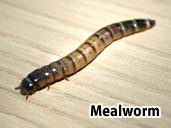
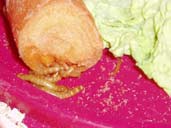
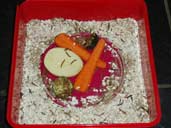
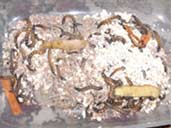
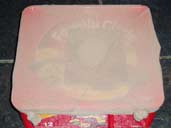 Mealworms should be housed in a well-ventilated plastic tub with a large surface area. The sides of the tub do not need to be high, but the extra floor space is appreciated. A RUB (really useful box), sandwich tub or old plastic biscuit tin are all fine. Air holes should be punched into the lid of the box for ventilation or alternatively cut a large section of the lid out with some sharp scissors and cover the hole with a fine mesh or a recycled pair of old tights (pantyhose).
Mealworms should be housed in a well-ventilated plastic tub with a large surface area. The sides of the tub do not need to be high, but the extra floor space is appreciated. A RUB (really useful box), sandwich tub or old plastic biscuit tin are all fine. Air holes should be punched into the lid of the box for ventilation or alternatively cut a large section of the lid out with some sharp scissors and cover the hole with a fine mesh or a recycled pair of old tights (pantyhose). 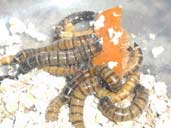 Fill the bottom of the tub with dry bran or oatmeal and this will serve as both a food and a substrate for the mealworms to burrow in. They will also eat dry bread and any wheat type produce.
Fill the bottom of the tub with dry bran or oatmeal and this will serve as both a food and a substrate for the mealworms to burrow in. They will also eat dry bread and any wheat type produce. 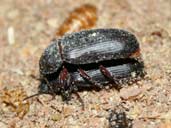 Mealworms are prolific breeders and will complete the cycle from egg to egg-laying adult within a few months depending on the food available and the temperature they are kept in.
Mealworms are prolific breeders and will complete the cycle from egg to egg-laying adult within a few months depending on the food available and the temperature they are kept in.